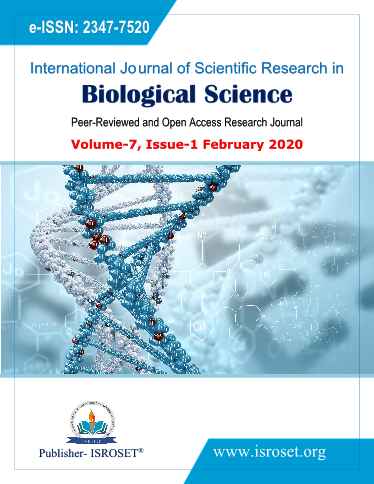Impact of sodium nitrate on astaxanthin production in green micro- alga Haematococcus pluvialis under laboratory condition
Keywords:
Astaxanthin, Carotenoid, Haematococcus pluvialis, Sodium NitrateAbstract
There is currently much interest in biological active compound derived from natural resources, especially compounds that can efficiently act on molecular targets, which are involved in various diseases. Astaxanthin is a xanthophyll carotenoid which is found in various micro-organisms and marine animals. astaxanthin is used as a pigment in aquaculture and food industries and has application in pharmaceutical and nutraceutical due to its high antioxidant activity. In addition, astaxanthin has important metabolic function including enhancement of immune reponses and protection against disease such as cancer. Haematococcus pluvialis is the richest source of natural astaxanthin and is now cultivated at industrial scale. Therefore, the main objective of this study was to observe the production of astaxanthin at different concentration of Nitrogen in Haematococcus pluvialis. The experiment was conducted for 18 days and data were analyzed at the interval of 2 days, the maximum concentration of carotenoid was recorded in Haematococcus pluvialis is 1.646µgmL-1 on 8th day at 20mM concentration of Sodium Nitrate.
References
C. Aflalo, Y. Meshulam, A. Zarka, S. Boussiba, "On the relative efficiency of two- vs. one-stage production of astaxanthin by the green alga Haematococcus pluvialis". Biotechnol. Bioeng., Vol.98, pp.300–305, 2007.
M. A. Borowitzka, J. M. Huisman, and A. Osborn, "Culture of astaxanthin - producing green alga Haematococcus pluvialis" I. Effects of nutrients on growth cell type. J. Appl. Phycol. Vol. 3, pp. 295-304, 1991.
S. Boussiba, A. Vonshak, "Astaxanthin accumulation in the green alga Haematococcus pluvialis". Plant Cell Physiol. Vol. 32, pp. 1077-1082, 1991.
S. Dong, Y. Huang, R. Zhang, S. Wang, Y. Liu, "Four different methods comparison for extraction of astaxanthin from green alga Haematococcus pluvialis". Scientific World Journal. Vol. 10, pp. 11- 15, 2014.
J. Fabregas, A. Dominguez, A. Maseda, A. otero, "Interaction between irradiance and nutrient availability during astaxanthin accumulation and degradation in Haematococcus pluvialis". App. Microbial. Biotechnol. Vol. 61, pp. 545-551, 2003.
M. Harker, A.J. Tsavalos, A.J. Young, "Autotrophic growth and carotenoid production of Haematococcus pluvialis in a 30 liter air-lift photobioreactor". J Ferment Bioeng. Vol. 82, pp.113–118, 1996.
Z. Y. Hu, Y.T. Li, M. Sommerfeld, F.Chen, Q. Hu, "Enhanced protection against oxidative stress in an astaxanthin-overproduction Haematococcus mutant". Eur J Phycol. Vol.43, pp. 365–376 , 2008.
M. Kobayashi, Y. Kurimura, T. Kakizono, N. Nishio, Y. Tsuji," Morphological changes in the life cycle of the green alga Haematococcus pluvialis". J Ferment Bioeng. Vol. 84, pp. 94–97, 1997.
Y. Li, M. Sommerfeld, F. Chen, Q. Hu, " Effect of photon fluxdensities on regulation of carotenogenesis and cell viability of Haematococcus pluvialis (Chlorophyceae)". J Appl PhycolVol. 22, pp. 253–263, 2010.
H. k. Lichtenthlar, "Chlorophylls and Carotenoids pigments of photosynthetic biorembranes". In Methods in Enzymology, Academic press, New York. Vol.148, pp.350-382, 1987.
P. Z. Margalith, "Production of ketocarotenoids by microalgae". Appl. Microbiol . Biotechnol. Vol. 51 pp. 431–438, 1999.
M. M. Mendes-Pinto, M. F. J. Raposo, J. Bowen, a. J., Young, Morais, R.. Evaluation of different cell disruption processes on encysted cells of Haematococcus pluvialis: Effects on astaxanthin recovery and implications for bio-availability. J. Appl. Phycol. Vol. 13, pp.19–24, 2001.
A. Ranga Rao, P. Siew Moi, S. Ravi, and R. G. Aswathanarayana, "Astaxanthin: sources, extraction, stability, biological activities and its commercial applications—are view". Mar. Drugs. Vol. 12, pp. 128–152, 2014.
I. Zlotnik, A. Sukenik, and Z. Dubinsky, "Physiological and photosynthetic change during the formation of red aplano spores in the chlorophyte Haematococcus pluvialis". J. Phycol. Vol. 29, pp. 463-469, 1993.
Downloads
Published
How to Cite
Issue
Section
License

This work is licensed under a Creative Commons Attribution 4.0 International License.
Authors contributing to this journal agree to publish their articles under the Creative Commons Attribution 4.0 International License, allowing third parties to share their work (copy, distribute, transmit) and to adapt it, under the condition that the authors are given credit and that in the event of reuse or distribution, the terms of this license are made clear.







